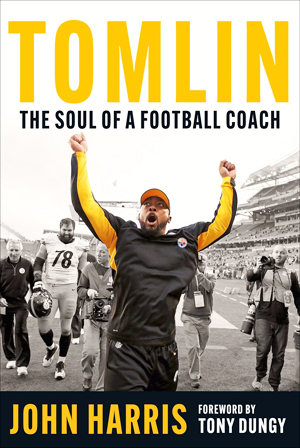
By Asia Nail
The Truth Reporter
In the realm where sports and culture intertwine, John Harris has stood as a beacon of insight for four decades. A seasoned journalist, Harris embarked on a remarkable journey, using his unique perspective to shine a light on the nuances of sports, race, and society.
“My journey started out with me just wanting to write for the newspaper,” shares Harris. “I was given the opportunity in 1980 to work at the Lexington Herald Leader newspaper in Kentucky. They had an opening for a sportswriter and the rest is history.”
Harris’ bylines have graced prominent publications such as the Pittsburgh Tribune-Review, Philadelphia Inquirer, Toledo Blade, and Tampa Bay Times. His recent work, encapsulated in the book Tomlin: The Soul of a Football Coach, unveils the layered narrative of Pittsburgh Steelers’ head coach, Mike Tomlin, and underscores Harris’ ability to weave hope through the fabric of American football.
John Harris is a crucial voice in the realm of sports and culture. As a Black man weaving narratives within the sports landscape, Harris brings a profound significance to his work. His articles serve as both a mirror and a compass, reflecting the intricate dynamics of race, opportunity, and legacy within the world of athletics.
In his exploration of topics such as “Black quarterbacks finding opportunity at small conference schools,” Harris dismantles stereotypes and sheds light on the evolving landscape of diversity in football. His work transcends the scoreboards, delving into the transformative power of sports to provide opportunities and ignite explosive growth for diverse athletes in often-overlooked arenas.
Harris’s commitment to amplifying stories that often go unheard is evident in his piece, “Pro Football Hall of Fame inductee Edgerrin James’ roots and legacy tied to HBCUs.” By exploring the connections between a football legend’s journey and Historically Black Colleges and Universities (HBCUs), Harris not only celebrates achievements but also highlights the vital role these institutions play in shaping the narrative of Black athletes.
“Looking back, my time at The Toledo Blade from 1998-2006 really helped me to expand my talents and to write about sports from a black man’s perspective,” says Harris.
Beyond the playing field, Harris’s skillset extends into the social justice realm, as seen in “Prairie View A&M at the forefront fighting against voter suppression.” Here, he magnifies the intersection of sports and civic engagement, emphasizing the role of athletes and institutions in combating social injustices, specifically the critical issue of voting rights in our country.
 In uncovering the story of Moses Fleetwood Walker, the first African American to play pro baseball, six decades before Jackie Robinson, Harris becomes a storyteller of historical milestones. By resurrecting narratives often confined to the shadows, he contributes to a more inclusive understanding of sports history, sharing, “Acknowledging the trailblazers who paved the way for future generations has always been one of my tenets.”
In uncovering the story of Moses Fleetwood Walker, the first African American to play pro baseball, six decades before Jackie Robinson, Harris becomes a storyteller of historical milestones. By resurrecting narratives often confined to the shadows, he contributes to a more inclusive understanding of sports history, sharing, “Acknowledging the trailblazers who paved the way for future generations has always been one of my tenets.”
John Harris’ journalism isn’t just about reporting scores though; it’s a testament to the transformative power of storytelling. In an era in which representation matters, Harris’s work serves as a beacon, inviting readers to explore the rich stories that define not only the games we love but also the broader landscape of American life.
“We lived in Toledo, Ohio for many years, all of them memorable. My wife Yulanda used to work for past mayor of Toledo, Jack Ford. She and my two sons, Myles and Langston, really help me to gain new perspectives on not only sports, but life in general.”
Harris’ passion for storytelling ignited when, after crafting an inspiring biography on NFL Hall of Famer, Edgerrin James, he sought his most recent project to delve into. His gaze fell upon the Pittsburgh Steelers and, more specifically, Mike Tomlin. Recognizing a void in the literary landscape, Harris embarked on a mission to explore the soul of a football coach whose essence resonates beyond the game.
What sets Harris apart as a writer is his tenacity in capturing the essence of figures like Tomlin, who, despite their prominence, often remain enigmatic.
In a world where media sensationalism often overshadows substance, Harris chose to navigate the uncharted waters of a coach who prefers actions over interviews. Tomlin’s reluctance to become the centerpiece of his own biography paralleled Harris’ commitment to unveil the man behind the iconic sunglasses and motivator persona.
“My endeavor in crafting this book was a compelling challenge — to artfully capture the essence of Mike Tomlin, illuminating his character and myriad accomplishments,” explains Harris.
“This task unfolded through insightful interviews with his former players, fellow coaches, family members, and other key individuals who have been integral to his journey.”
Harris goes on to explain that Mike’s older brother Ed gave him invaluable insights for the new book as well as many of his past players. “Everyone I’ve spoken with speaks highly of Coach Tomlin and cherishes his humble demeanor. Mike has always been comfortable interacting and communicating with people who maybe didn’t look like him, and still he has never lost sight of who he is.”
In their school days, Harris learned that Tomlin was around many other athletes from different backgrounds, which explains why he’s such a well-rounded coach today. “He originally wanted to play for the NFL after starting as wide receiver for William and Mary College. When that plan didn’t work out, Tomlin was determined to be a coach. He’s not only a coach, he’s a husband, a dad and an overall good guy.”

In the ever-evolving landscape of American football, Harris weathers the changes as both witness and chronicler. His journalistic lens extends far beyond the gridiron, capturing the heartbeat of a nation that grapples with societal shifts. “I do my best to navigate the delicate intersection of sports and culture, using my platform to amplify voices that may otherwise go unheard,” says Harris.
Through his work, he champions the idea that football is not just a game; it’s a microcosm of American society, a stage where narratives of triumph and struggle play out, echoing the broader lessons of life.
As a Black journalist, Harris not only covers sports but has become a storyteller of the human experience. His reflections on Mike Tomlin’s journey echo themes of resilience and the pursuit of greatness against the backdrop of race and expectations. In an era where diversity and representation are paramount, Harris’ work transcends the sports pages, providing a lens through which readers can understand the complexities of leadership, motivation, and triumph on a more personal level.
Harris’ exploration of Tomlin’s coaching philosophy reveals not only strategic brilliance but also the profound influence his representation has on both player and fans alike. “Tomlin is the same when the team plays great and when they play badly. He is consistent, everyday focused on getting better individually and collectively; that transcends race.” shares Harris.
Through his meticulous research and interviews, in the book Harris unveils Tomlin’s motivations, delving into the psyche of a coach who simply aspired to be the mentor he always wanted as a player.
“Football is the ultimate team sport,” explains Harris. “He has the players in the locker room on board with his message, teachings and motivations. If you lose the locker room, as they say, you lose the team. After 17 years he has never lost the Steelers locker room.”
As a Black journalist, Harris brings a perspective that enriches the narrative, offering readers a nuanced understanding of the challenges and triumphs faced by Black coaches and players in a predominantly white industry.
2023 was a very interesting start to the football season because the Stealers struggled. Critics in the media wondered if Tomlin’s coaching had run its course in Pittsburgh. “The deciding factor is always how the team responds,” adds Harris.
“When the team was at its lowest this season, the Steelers still played their best. Fans agree that had Tomlin lost his team, he would not have gotten this stellar performance from his players.”
Harris has become a storyteller who illuminates the paths less traveled. His coverage of Tomlin’s challenges, victories, and the delicate dance between players and coaches paints a portrait of a sport that extends beyond the field, carrying the weight of societal expectations and cultural dynamics.
All are welcomed to join John Harris for an engaging evening at his upcoming Q&A book event, proudly sponsored by the Lucas County Library and the Toledo Blade. Mark your calendars for Tuesday, January 16, at 7 pm, hosted at the vibrant downtown main library located at 325 Michigan Street, Toledo, Ohio 43604. Don’t miss the chance to meet this distinguished author in an enriching discussion about his work.
As Harris reflects on the past 40 years, his journey becomes a testament to the power of storytelling, the resilience of individuals, and the transformative potential of football as a mirror reflecting the soul of a nation. “There’s no secret to success as a writer. I simply followed my impulses and my dreams,” shares the author.
Through his lens, Harris invites readers to contemplate not just the game, but the people who shape it and, in turn, are shaped by it – a powerful narrative that transcends sports and resonates as a hopeful American story.
Follow John Harris @ andscape.com/contributors/john-harris
